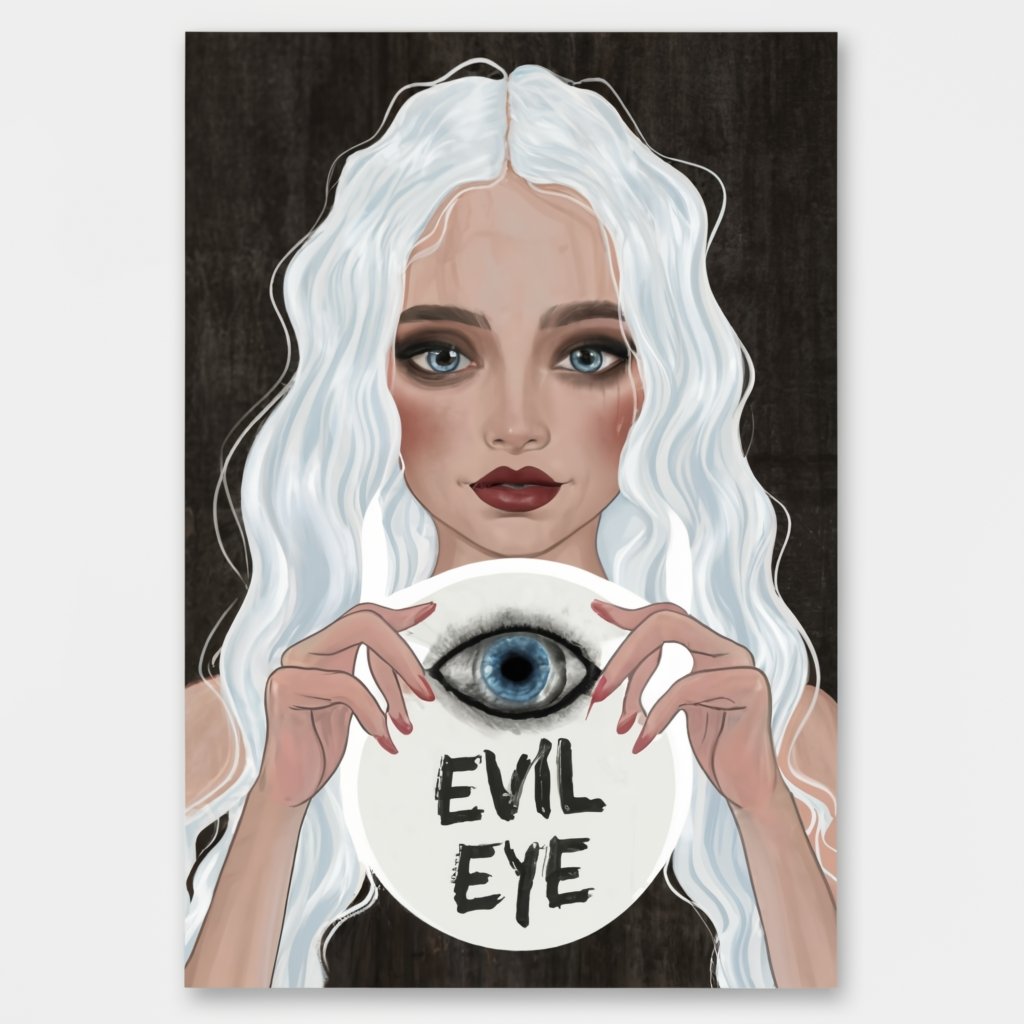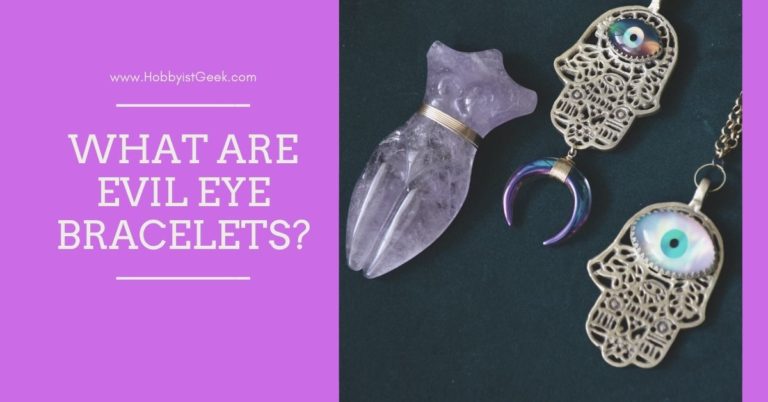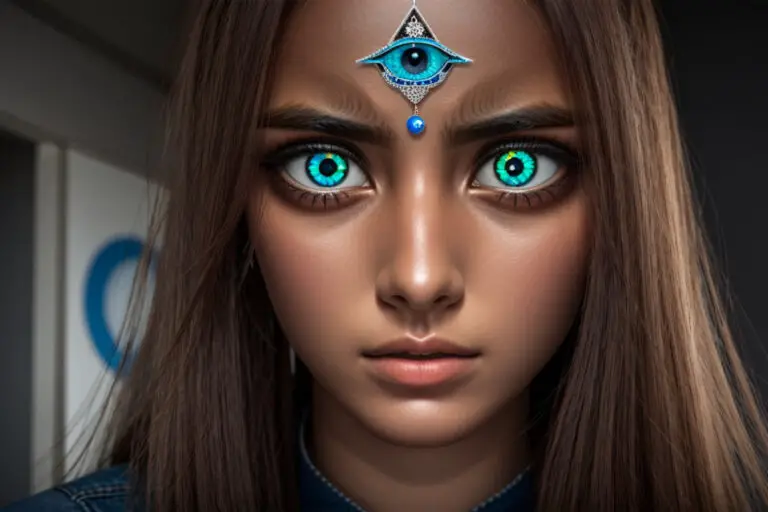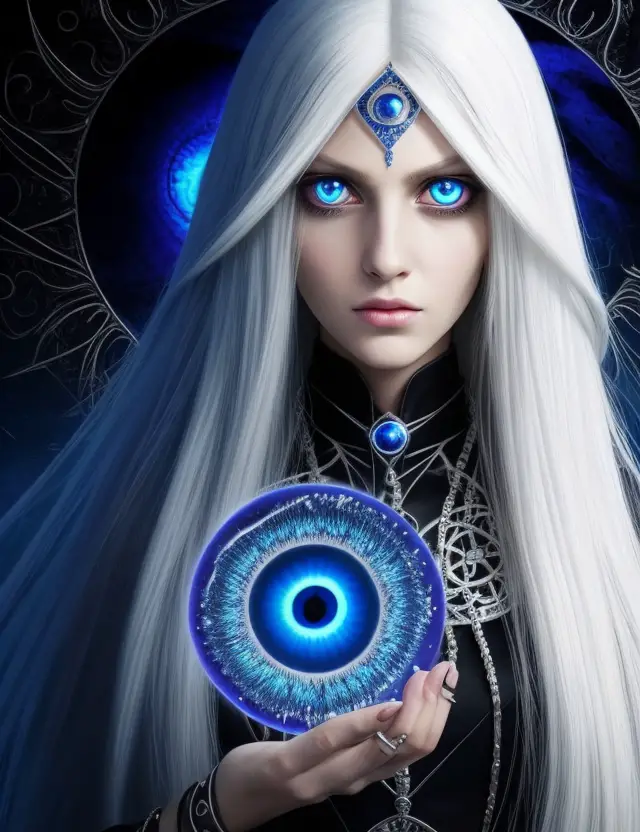Is The Evil Eye Bad?: A Deep Dive into Evil Eye Taboos
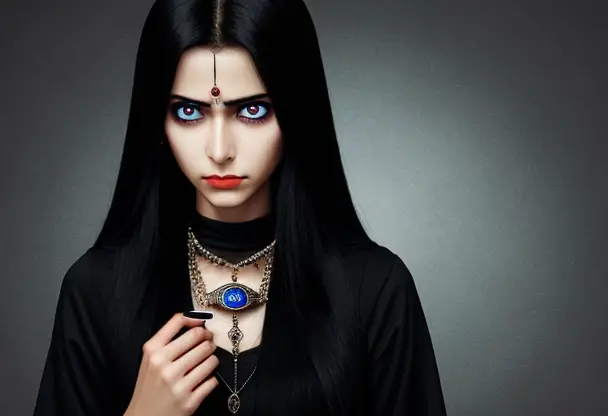
Introduction
Is The Evil Eye Bad? In this article, we embark on a journey to demystify the misconceptions surrounding this ancient and fascinating phenomenon.
The Evil Eye has long been shrouded in negative perceptions and surrounded by myths and superstitions that have perpetuated misunderstandings throughout history.
I am here to shed light on the reality behind these taboos and delve into the cultural insights that shape our understanding. The concept of the Evil Eye is deeply rooted in various cultures around the world, spanning centuries and continents.
It has been an object of both fascination and trepidation for countless generations. Most often associated with a gaze or unintentional harm caused by envy or jealousy, the Evil Eye has become synonymous with misfortune.
Yet, it is essential to debunk these misconceptions and uncover the truth hidden beneath layers of folklore. To truly comprehend Evil Eye taboos, one must first understand their origins and significance within different cultural perspectives.
These beliefs vary greatly across regions, from Mediterranean countries like Greece and Turkey to South Asian countries like India and Pakistan. Each culture contributes unique insights into this mystical phenomenon, weaving a tapestry of diverse interpretations.
It is crucial to challenge common stereotypes associated with the Evil Eye. Often portrayed as something inherently sinister or malevolent, these notions fail to capture its true essence.
By exploring its historical context within different societies, we can illuminate how it intertwines with daily life rather than merely indulging in sensationalism. By shedding light on the reality behind Evil Eye taboos, we hope to dispel unnecessary fear while promoting a deeper understanding of cultural practices that have endured for centuries.
Through knowledge and enlightenment, we can navigate through cultural beliefs respectfully while appreciating their significance. In our quest to demystify these misunderstandings about the Evil Eye, let us leave behind preconceived notions and embark on an eye-opening journey of discovery.
Join us as we unravel the intricacies of this fascinating subject, exploring the cultural insights and beliefs that fuel these enduring taboos. Together, we shall unveil the truth that lies beyond the veil of superstition and deepen our appreciation for the diverse tapestry of human cultures.

Unraveling Evil Eye Misconceptions
Unraveling Evil Eye Misconceptions When it comes to the mysterious powers of the evil eye, there are certainly a fair share of misconceptions floating around. This age-old belief has long been shrouded in fear and negativity, often leading to widespread misunderstandings.
But let’s take a step back and debunk some of these common misconceptions. Firstly, it’s important to understand that the evil eye is not some malevolent force waiting to strike at unsuspecting victims.
Contrary to popular belief, it is not a curse or an enchantment cast upon someone with ill intentions. Rather, the concept of the evil eye centers around the idea that certain individuals possess an innate ability to unintentionally cause harm or misfortune through their gaze.
One myth that needs busting is the idea that anyone can give someone else the evil eye intentionally. In reality, this belief revolves around an involuntary occurrence where envy or excessive admiration directed towards another person can inadvertently transmit negative energy through one’s gaze.
It is not a deliberate act but more of an unconscious phenomenon deeply embedded in cultural beliefs. Cultural perspectives also play a significant role in shaping our understanding of the evil eye.
Different societies interpret and respond to this concept in diverse ways, leading to variations in superstitions and taboos associated with it. What might be considered as bad luck due to the evil eye in one culture could be seen as unrelated events by another.
As we demystify these misconceptions surrounding the evil eye, it becomes evident that our fear and negative perceptions have led us astray from its true essence. By gaining deeper cultural insights and understanding different perspectives on this phenomenon, we can strip away stereotypes and embrace a more nuanced view.
Unraveling the intricacies of evil eye misconceptions enables us to see beyond fear and recognize its reality for what it truly is—a complex belief rooted in cultural traditions and shared experiences across various societies. By dispelling myths and debunking misconceptions, we can foster a greater understanding of the evil eye and demystify its role in our lives.
The Truth Behind Negative Perceptions: Evil Eye Debunked
The Truth Behind Negative Perceptions: Evil Eye Debunked When it comes to the evil eye, there are plenty of negative perceptions floating around. However, it’s essential to separate fact from fiction and debunk these misconceptions.
One prevailing myth is that anyone with an evil eye can deliberately harm others just by looking at them. This belief has led to taboos and superstitions in various cultures, causing fear and misunderstanding.
But let’s take a step back and demystify the reality behind these negative beliefs. Contrary to popular belief, the evil eye is not some malevolent force wielded by individuals with ill-intent.
Rather, it is a concept deeply rooted in cultural beliefs and folklore. The evil eye originated as a way to explain misfortune or illness that seemingly occurred without any logical explanation.
Over time, this concept evolved into superstitions surrounding the gaze of envy or jealousy. Understanding the origins of these beliefs helps shed light on their true nature.
The evil eye is not about causing harm; it’s about warding off misfortune brought upon by others’ envy or jealousy. It is a cultural insight into how different societies have tried to explain events that seemed beyond their control.
Moreover, the idea that someone can consciously inflict harm through simply looking at another person is nothing more than a stereotype perpetuated by misunderstandings and exaggerations over time. It’s important to recognize that cultures around the world have variations in their interpretations of the evil eye phenomenon, adding depth and richness to our understanding.
By debunking these negative stereotypes surrounding the evil eye, we can embrace a more accurate perspective rooted in cultural context. Rather than living in fear of an imagined curse cast through mere glances, we can appreciate the intricate beliefs and traditions associated with this concept.
In essence, demystifying these misconceptions allows us to view the evil eye for what it truly represents within cultural perspectives—an attempt by different societies to explain and protect against misfortune. By doing so, we can challenge our preconceived notions and foster a greater understanding of the reality behind this age-old belief.
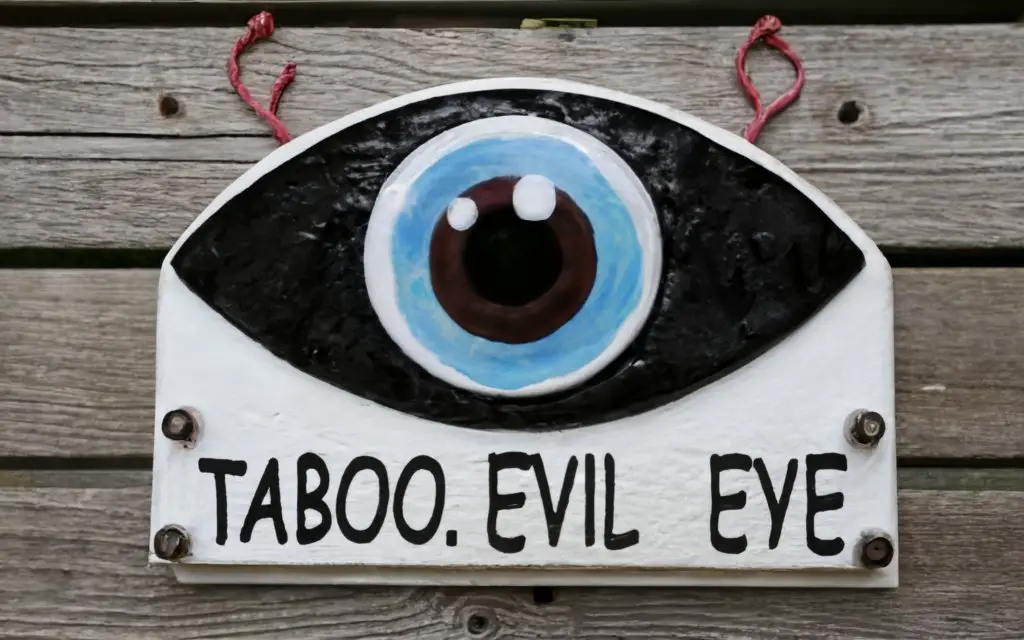
Dispelling Myths: Understanding Evil Eye Taboos
Dispelling Myths: Understanding Evil Eye Taboos When it comes to evil eye taboos, there are plenty of myths and misunderstandings that surround this ancient concept. Let’s delve into the reality of these beliefs and debunk some common misconceptions.
One prevalent myth is that the evil eye can only be cast intentionally by malicious individuals. Contrary to this belief, the evil eye is often unintentional and can be cast unknowingly by anyone.
It’s important to understand that the evil eye is not a deliberate act of harm; rather, it’s believed to result from admiration or envy directed towards someone. So, next time you catch yourself admiring your friend’s new car or beautiful home, rest assured that you are not intentionally casting an evil eye upon them!
Another misconception surrounding evil eye taboos is that they are universally practiced and believed in the same way across cultures. However, cultural perspectives play a significant role in shaping beliefs and superstitions related to the evil eye.
Different cultures have their own unique interpretations of how the evil eye manifests and what precautions should be taken against it. For example, in Mediterranean cultures like Greece and Turkey, blue amulets known as “nazar” are widely used as protective talismans against the evil eye.
These amulets are believed to ward off negative energy caused by envy or admiration. On the other hand, in Middle Eastern cultures such as Egypt or Lebanon, people may resort to reciting specific prayers or wearing certain symbols as protection against the curse.
It’s essential not to fall into stereotypical thinking when it comes to understanding these cultural practices and beliefs. The reality is that various taboos associated with the evil eye differ across regions and communities due to historical influences, religious customs, and individual interpretations.
By demystifying these misunderstandings surrounding evil eye taboos, we can gain a deeper appreciation for diverse cultural insights while respecting individual beliefs without fear or judgment. It’s crucial to approach these traditions with an open mind, recognizing that they hold significance for the communities that follow them.
In the next section, we will further explore the cultural context of evil eye superstitions and shed light on how these beliefs have evolved over time. Let’s continue our journey to gain a comprehensive understanding of this intriguing phenomenon.
What is the Evil Eye Symbol? Should I be worried?
Cultural Perspectives on the Evil Eye vary greatly around the world. In some cultures, the belief in the evil eye is deeply ingrained and plays a significant role in people’s daily lives. For example, in Mediterranean countries such as Greece and Turkey, there is a long-standing tradition of wearing evil eye charms or amulets to ward off its supposed negative effects.
These cultural practices are rooted in a belief that jealousy and envy can bring harm to others through a malevolent gaze. In other cultures, however, the concept of the evil eye may be seen as nothing more than an old superstition with no basis in reality.
Skeptics argue that attributing misfortunes to someone casting an evil eye is simply a way to explain random events or occurrences that defy explanation. They debunk these beliefs by emphasizing the lack of scientific evidence supporting such claims.
It’s essential to understand that cultural perspectives shape our beliefs about the evil eye, and dismissing them outright as mere myths or misconceptions would be oversimplifying their significance. The cultural insights gained from exploring different viewpoints allow us to demystify this phenomenon while appreciating its historical context.
Furthermore, it’s important not to generalize all cultural perspectives on the evil eye under one umbrella term. Each culture has its unique understanding and interpretation of this concept.
By engaging in open dialogue and listening to diverse voices, we can challenge stereotypes surrounding these beliefs and gain a deeper appreciation for cultural diversity. Navigating cultural perspectives on the evil eye requires an open mind and sensitivity towards different beliefs.
While some view it as a profound reality with far-reaching consequences, others see it as nothing more than baseless superstitions or misunderstandings. By engaging with various cultural insights and shedding light on these taboos, we can work towards demystifying misconceptions while fostering mutual understanding and respect among different cultures worldwide
Challenging Common Beliefs: Evil Eye Misconceptions Exposed
When it comes to evil eye taboos, there are numerous common beliefs that have been perpetuated over time. However, it is important to challenge these beliefs and expose the misconceptions surrounding the evil eye.
One prevalent misconception is that anyone can give or receive the evil eye simply by looking at someone with envy or ill intentions. This belief has led to a lot of fear and paranoia, as people constantly worry about inadvertently causing harm to others or being affected by the evil eye themselves.
In reality, the truth is more nuanced. The concept of the evil eye varies across cultures and there are different interpretations of how it works.
While some cultures believe in a literal gaze that can cause harm, others view it as a metaphorical representation of envy’s negative impact on an individual’s well-being. By demystifying this misconception, we can understand that not every envious glance is capable of casting a curse upon someone.
Another misconception tied to the evil eye revolves around protective amulets and charms. Many believe that wearing certain symbols or carrying talismans can ward off the effects of the evil eye.
While these amulets hold cultural significance and provide individuals with a sense of security, they should not be solely relied upon for protection against negativity. Furthermore, there is often a stereotype associated with people who are believed to possess an “evil eye.” This stereotype portrays them as malicious individuals intentionally inflicting harm upon others through their gaze.
However, this portrayal fails to consider cultural context and perpetuates misunderstandings about different belief systems. It’s vital to recognize that labeling someone as having an “evil eye” based on such stereotypes only perpetuates fear and prejudice.
By challenging these common beliefs surrounding the evil eye and exposing their misconceptions, we can demystify this notion and gain a clearer understanding of its cultural significance. It is essential to approach these taboos with open-mindedness and respect for diverse cultural perspectives in order to truly comprehend the complexities and nuances of the evil eye phenomenon.
Breaking Down Stereotypes: The Reality of Evil Eye Taboos
Breaking Down Stereotypes: The Reality of Evil Eye Taboos When it comes to evil eye taboos, there are numerous stereotypes and misconceptions that often cloud people’s perceptions. These misunderstandings can lead to fear and an inaccurate understanding of the true nature of the evil eye concept.
However, it is essential to demystify these misconceptions and shed light on the reality behind evil eye taboos. One common stereotype associated with the evil eye is that it is solely a negative force used intentionally to harm others.
This belief perpetuates the idea that individuals who possess the power of the evil eye are malicious or have ill intentions towards others. However, this couldn’t be further from the truth.
In reality, the concept of the evil eye transcends cultures and has been present for centuries as a way to explain misfortune or illness. It is not an intentional act but rather believed to be an unconscious projection of envy or admiration.
To truly understand evil eye taboos, we must also debunk another myth surrounding them – that it solely affects individuals who are wealthy or prosperous in some way. While it is true that people who appear successful may attract more attention, the evil eye can affect anyone regardless of their social status or material possessions.
This misconception only serves to perpetuate stereotypes and fails to capture the essence of what truly lies behind this cultural belief. It’s important to recognize that cultural perspectives heavily influence how communities interpret and respond to the concept of the evil eye.
Different societies have their own unique beliefs and practices surrounding this phenomenon, each reflecting their own values and traditions. By exploring these diverse cultural insights, we gain a deeper appreciation for how these taboos manifest in various parts of our world.
By challenging stereotypes associated with evil eye taboos, we begin to unravel its true nature – one rooted in ancient folklore and shared human experiences across cultures. Understanding its reality allows us to approach this concept with a more open mind, free from preconceived notions and fears.
It is only through demystifying these misconceptions that we can appreciate the rich tapestry of beliefs and traditions that make up our global community. So let us embrace the opportunity to learn, appreciate, and respect these cultural taboos rather than perpetuating outdated stereotypes.
Cultural Context of Evil Eye Superstitions: A Deep Dive
Cultural Context of Evil Eye Superstitions: A Deep Dive To truly demystify the evil eye and understand its significance in various cultures, we must delve into the cultural context that surrounds it. The concept of the evil eye has a rich history and can be traced back to ancient civilizations such as Mesopotamia and Egypt.
It is believed that these societies held strong beliefs in the power of the gaze to bring harm or misfortune upon others. This idea has persisted throughout time, evolving into different forms across cultures.
In many Mediterranean cultures, including Greece, Turkey, and Italy, the evil eye is seen as a powerful force with both positive and negative aspects. It is believed that individuals possess this innate ability to inadvertently cause harm simply by giving someone an envious or covetous look.
This understanding creates a culture rooted in protective measures against jealousy and envy, leading to various superstitions designed to ward off ill effects. Understanding these cultural perspectives sheds light on why certain behaviors are deemed taboo when it comes to encountering the evil eye.
For example, you might come across people wearing amulets or charms in the shape of eyes – known as nazar – as protection against its malevolent influence. Others might resort to rituals involving salt or garlic believed to cleanse negative energy associated with the evil eye.
It’s important not to dismiss these practices as mere superstitions without appreciating their deep-rooted meanings within specific cultural contexts. While some may view them as baseless beliefs or misunderstandings, they hold immense significance for those who adhere to them.
By exploring these cultural insights, we can challenge common misconceptions surrounding the evil eye phenomenon. Rather than dismissing it outright as irrational fear or unfounded beliefs, we gain a deeper appreciation for its role in shaping communities’ daily lives.
As our understanding evolves beyond stereotypes and preconceived notions about evil eye taboos, we begin dismantling long-held misunderstandings around this intriguing aspect of human belief. Embracing cultural diversity and recognizing the power of beliefs and superstitions allows us to engage in meaningful conversations that bridge gaps and foster understanding between different cultures.
Beyond Fear: Reevaluating Misconceptions About the Evil Eye
Beyond Fear: Reevaluating Misconceptions About the Evil Eye When it comes to the evil eye, fear seems to be at the forefront of people’s minds.
The mere mention of this age-old belief can send shivers down one’s spine. But what if I told you that it’s time to take a step back and reevaluate our misconceptions?
Let’s demystify this phenomenon and debunk some common stereotypes. One prevalent misunderstanding about the evil eye is that it is an inherently negative force, associated solely with malevolence and ill intent.
However, cultural perspectives on the evil eye vary greatly across different regions. In some cultures, there is a belief that envy or admiration can inadvertently cause harm through the power of the gaze.
This means that not all taboos surrounding the evil eye carry negative connotations. It’s essential to understand that our fears often stem from cultural superstitions and myths rather than actual reality.
While it’s true that certain cultures have specific practices or rituals to ward off the evil eye, these are rooted in long-standing beliefs rather than concrete evidence. By examining various cultural insights into this phenomenon, we can gain a deeper understanding of its origins and significance.
Another misconception worth challenging is that the evil eye operates as a mystical force beyond human comprehension. In reality, many anthropologists and psychologists argue that these beliefs serve as mechanisms for explaining success or failure in social interactions.
They provide a framework for understanding why some individuals may experience misfortune while others thrive. By shedding light on these misunderstandings and exploring different cultural perspectives, we can begin to disentangle ourselves from unfounded fears surrounding the evil eye.
It’s crucial to approach such beliefs with an open mind and recognize their historical and cultural significance rather than immediately dismissing them as irrational. Our perception of the evil eye has been shaped by deep-rooted taboos, beliefs inherited from generations past, and fears instilled through cultural narratives.
However, by delving into the reality behind these superstitions, we can demystify this phenomenon and challenge the negative perceptions associated with it. It’s time to reevaluate our misconceptions, embrace cultural insights, and approach the evil eye with a newfound understanding.
Debunking the Dark Side: Shedding Light on Evil Eye Taboos
In order to fully grasp the essence of evil eye taboos, it is crucial to debunk the dark side and shed light on this intriguing topic. Many people associate the evil eye with darkness, malevolence, and harm.
However, by delving into its origins and cultural perspectives, we can demystify these misconceptions. Evil eye taboos are deeply rooted in ancient belief systems across various cultures.
Although often regarded as mere superstitions in modern times, they hold significant cultural insights that can help us understand the complexities behind these practices. It is essential to acknowledge that these taboos are not solely based on fear or irrational beliefs; rather, they stem from a collective understanding of cultural norms and customs.
Misunderstandings arise when people perceive evil eye taboos through the lens of their own cultural upbringing or preconceived notions. Myths and stereotypes surrounding this phenomenon often overshadow its true essence.
By exploring different perspectives and challenging our own preconceptions, we can gain a deeper understanding of the reality behind evil eye taboos. One common misconception about the evil eye is that it is exclusively associated with ill intentions or malicious acts of envy.
While there may be instances where negative perceptions are attached to the evil eye, it’s important to recognize that this belief system encompasses more than just malevolence. Evil eye taboos also serve as a symbol of protection against harm and misfortune.
To truly appreciate the significance of evil eye taboos within certain cultures, we must consider their historical context. These beliefs have been passed down through generations as a way to navigate life’s uncertainties and protect loved ones from potential harm.
By acknowledging this cultural heritage and its role in shaping beliefs surrounding the evil eye, we gain a more nuanced perspective on why such taboos exist. Ultimately, shedding light on evil eye taboos involves fostering open-mindedness and embracing diverse cultural practices without judgment or prejudice.
By debunking the dark side and dispelling misconceptions, we can appreciate the rich tapestry of beliefs that make up our world. Evil eye taboos offer a glimpse into the intricacies of human perception, unearthing ancient wisdom that continues to shape our understanding of ourselves and others.
Cultural Insights: Demystifying Evil Eye Misunderstandings
11. Cultural Insights: Demystifying Evil Eye Misunderstandings When exploring the cultural insights surrounding evil eye misconceptions, it becomes clear that these beliefs are deeply rooted in various societies around the world. Different cultures may have their own unique perspectives and interpretations of the evil eye phenomenon, leading to a wide range of taboos and superstitions associated with it.
For example, in Mediterranean countries like Greece and Turkey, blue-colored amulets known as “Nazar” are commonly used to ward off the evil eye. These cultural practices not only reflect the shared beliefs of a community but also serve as a way to protect against negative energies and bring good fortune.
One important aspect to demystify about evil eye misunderstandings is that these beliefs are not solely based on fear or negative perceptions. While some may view the evil eye solely as an instrument of harm or envy, others see it as a natural force that can affect both humans and objects alike.
The idea is rooted in a belief that certain individuals possess an unintentional power to cause harm through their gaze or thoughts. By understanding this cultural perspective, we begin to see how these misconceptions arise from a desire to protect oneself from potential harm.
It is important to note that misinformation plays a significant role in perpetuating stereotypes about the evil eye. Often portrayed as something sinister or malevolent in popular culture, these portrayals fail to capture the full scope of its meaning within various cultures.
By debunking myths and shedding light on the reality behind evil eye taboos, we can challenge these misguided perceptions. Moreover, understanding that different societies have distinct interpretations of the evil eye allows us to appreciate the richness of their traditions and folklore.
Each culture brings its own unique set of superstitions and customs surrounding this phenomenon, showcasing how diverse perspectives shape our collective understanding. In order to truly demystify evil eye misunderstandings, it is essential to engage with cultural contexts and explore the beliefs and practices that underpin these taboos.
By doing so, we can move beyond surface-level assumptions and gain a deeper appreciation for the significance of the evil eye within different communities. It is through this lens that we can begin to foster greater cultural understanding and bridge gaps in knowledge, ultimately dispelling misconceptions surrounding this captivating cultural phenomenon.
Conclusion for Is The Evil Eye Bad?
Debunking the misconceptions surrounding evil eye taboos is essential to gaining a deeper understanding of cultural beliefs and traditions. By demystifying the negative perceptions and shedding light on the reality behind these superstitions, we can challenge common stereotypes associated with the evil eye.
It is crucial to acknowledge that fear and misunderstandings often arise from a lack of knowledge or exposure to different cultural perspectives. Through this exploration, we have learned that evil eye beliefs vary across cultures, each with its own unique insights and interpretations.
By embracing cultural insights and open-mindedness, we can appreciate the rich tapestry of beliefs that exist in our global community. Let us strive to debunk misconceptions, break down stereotypes, and foster an atmosphere of respect and acceptance for diverse traditions and practices.
Frequently Asked Questions
1. What is the Evil Eye, and why is it considered taboo?
The Evil Eye is a belief that a person can cast a malevolent gaze, often unintentionally, leading to harm or misfortune. Explore the origins of this superstition and the cultural taboos associated with it in our in-depth article.
2. How do different cultures interpret the Evil Eye?
Delve into the fascinating variations in the interpretation of the Evil Eye across different cultures. Uncover the common threads and unique nuances that shape the beliefs surrounding this ancient phenomenon.
3. Can the Evil Eye affect anyone, or are certain individuals more susceptible?
Discover the factors that are believed to make individuals more vulnerable to the effects of the Evil Eye. Our article explores whether certain traits or situations increase the likelihood of falling victim to this superstition.
4. Are there protective measures against the Evil Eye?
Learn about the diverse protective rituals and charms that various cultures employ to ward off the Evil Eye. From amulets to specific prayers, understand the practices aimed at safeguarding individuals from its perceived negative influence.
5. How has the perception of the Evil Eye evolved over time?
Trace the historical evolution of beliefs surrounding the Evil Eye. Explore how modern perspectives may have shifted, adapted, or persisted, and how this ancient superstition continues to influence cultural practices and taboos today.
If you liked this article you will love The Science Behind Evil Eye: Unmasking Mysteries!
- Jewelry Making Ideas: Seasonal Crystal Trends That Command Premium Prices - May 31, 2025
- Evil Eye Hand: Unveiling the Mystical Origins and Meanings - February 2, 2024
- Amegreen Amethyst Meaning: Discover the Hidden Magic! - February 2, 2024

